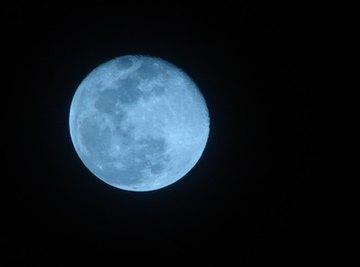
Man has looked to the moon for guidance since Paleolithic times. Civilizations throughout history have monitored the moon's phases to keep track of time, to guide them in planting and harvesting crops and to pinpoint auspicious times at which to end or begin their endeavors. A lunar cycle is completed approximately every 29 days, during which various moon phases occur. By learning to identify and determine each phase of the moon, you can put your understanding to practical use.
Understand the direction that the moon phases travel in and how to distinguish waxing from waning. Each phase is dependent on the portion of the moon illuminated by the sun's light. A full moon occurs when 100 percent of one side of the moon's surface is visible. The full moon gradually transitions to a new moon, which occurs when the moon is no longer visible in the sky. The shadow cast on the moon revolves in a right to left fashion. When the shadow is progressing towards a new moon, the moon phase is waning. When the shadow is shrinking and progressing towards a full moon, the moon phase is waxing. The moon is waning when any portion of the moon's right half is not visible or when the illuminated sliver is on the left. The moon is waxing when the illuminated sliver is on the right, or if the left half of the moon is predominantly shadowed. Observe the moon for two or three successive nights to fully determine which direction the moon's shadow is traveling in.
Become familiar with each moon phase so that you can easily identify them. The phase following the new moon is called the new crescent. A sliver of the right half of the moon will be illuminated. This is followed by the first quarter, when the right half of the moon's face is illuminated. Next is the waxing gibbous, where only a small sliver on the left of the moon is not visible, which is followed by the full moon. The waning gibbous occurs when most of the moon's left side is visible, followed by the last quarter moon, when the left half is illuminated. The old crescent appears as an illuminated sliver on the left, then the cycle repeats.
View the moon at night to observe its phase. Sometimes the moon is obscured by clouds, impractical to view or inaccessible. In these instances, an almanac or Internet database comes in handy. Almanacs are printed annually and detail each moon phase for the current year. Online moon phase calendars, such as the U.S. Naval Observatory moon phase database, provide quick and reliable access to current, future and past moon phases. Refer to a reference for utmost convenience.
References
About the Author
Jessica Conner broke into the online writing field in 2010 when she published articles for a local news website covering art-related topics. She now writes full time for various websites. She resides in South Louisiana and attended the University of Louisiana for visual arts.
Photo Credits
moon image by Stefan Häuselmann from Fotolia.com
